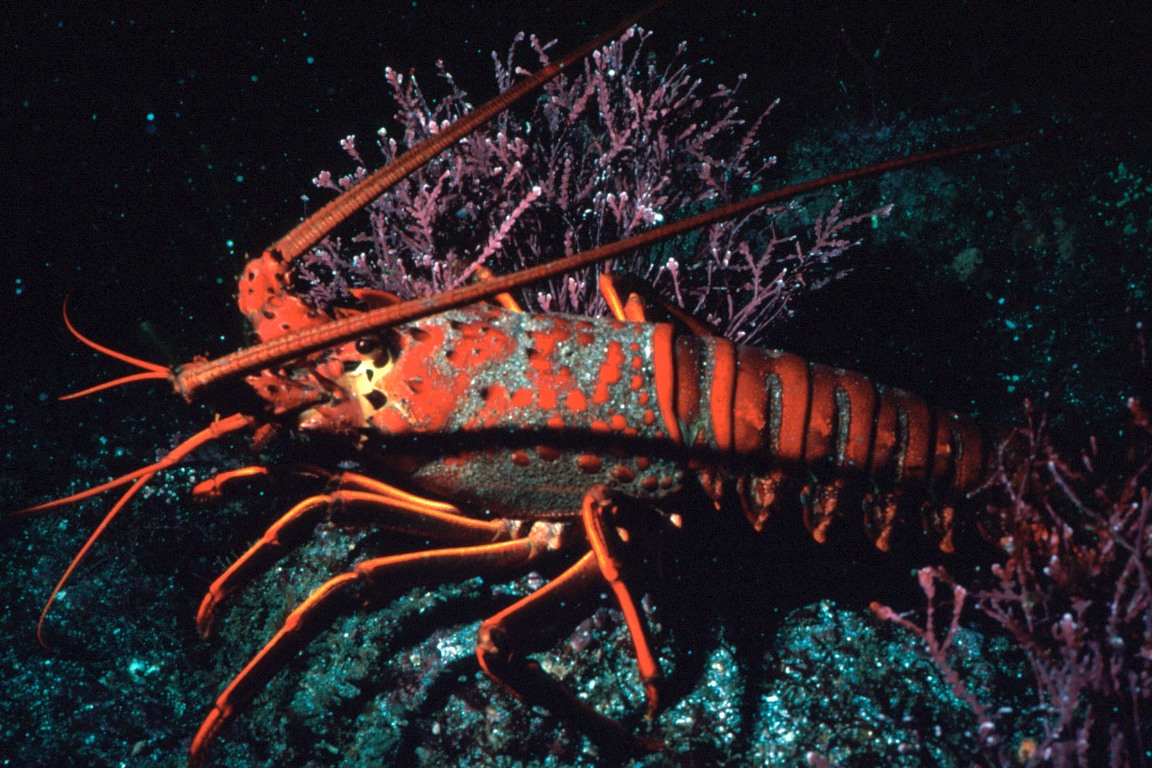- California spiny lobster
Taxobox | name = California spiny lobster

image_width = 250px
image_caption =
regnum =Animal ia
phylum =Arthropod a
subphylum = Crustacea
class =Malacostraca
ordo =Decapoda
infraordo =Achelata
familia = Palinuridae
genus = "Panulirus "
species = "P. interruptus"
binomial = "Panulirus interruptus"
binomial_authority = Randall, 1842The California spiny lobster is a species of
spiny lobster found from the southern tip of theBaja California Peninsula toMonterey Bay ,California .Distribution
They are generally found at very shallow depths near the coastline or near offshore islands. They migrate in order to mate and to give birth to their young. During the spring, California spiny lobster travel to shallow waters and then move to deeper waters in the fall. In December, they often move offshore to waters as deep as 35m (110feet). By late January, the lobsters generally move back up to depths between 4 and 12m (15 and 45feet) of water.
The California spiny lobster is generally
nocturnal ; during the day, these spiny lobsters can be found in hiding places such as small holes and cracks, or hidden in grass with other lobsters, but at night, they tend to hunt singly.Ecology
Spiny lobsters are scavengers that mainly eat
sessile or slow-moving animals, such assnail s,sea urchin s,clam s, sponges,kelp ,worm s,mussel s,scallop s,barnacle s, and fish. California spiny lobsters are a vital part of the California coast habitat because they keep the purple and redsea urchin population under control. The jaws of the California spiny lobster are extremely strong, and they are capable of crushing shells and bones of other animals.Predators of the California spiny lobster include
giant sea bass ,kelp bass ,California sheephead ,California scorpionfish , rockfishes,octopus , Californiamoray eel s,sea otter s,cabezon ,horn shark s, leopard sharks, other lobsters, and humans.Reproduction
Mating takes place between January and April, with theventral sides of the male and female animal against each other, during which asperm packet is transferred from the male to the female. When the female spiny lobster is ready, she will scratch open the sperm packet with specializedclaw s while simultaneously releasing her eggs. Once the sperm have fertilized the eggs, they will stick to thepleopod s (swimmerets) and stay there until hatched. A newly matured female will produce about 100,000 eggs while an older and larger female will make nearly 1,000,000. When the female spiny lobster is ready to release the fertilized eggs she goes to shallower, warmer water, usually in May or June. The eggs are bright red when first fertilized, but become dark brown after about ten weeks.The eggs hatch into "Phyllosoma"
larva e, which look quite unlike the adult, and are free-floating creatures with very little mobility or defence. After about six to nine months, when the larva has molted 12 times, it will reach the "puerulus" (from theLatin meaning child) stage. This looks like a small lobster with very large antennae. The "puerulus" moves very close to shore where it molts into a juvenile spiny lobster.Back in the days before divers went down to pick them by hand, spiny lobsters often grew to be 150 years old and over 1 m (3ft) long.Fact|date=August 2007 These giant spiny lobsters were too big to fit into any traps, and had very few predators. Most spiny lobsters now grow to the age of five to seven years before being caught. The largest on record was 16 pounds, 1 ounce, caught at Catalina Island in 1968 by Jim Watt on Scuba gear, according to the California Department of Fish and Game records. [cite book |url=http://www.dfg.ca.gov/mrd/status/ca_spiny_lobster.pdf |title=California Spiny Lobster |author=Kristine C. Barsky |publisher=
California Department of Fish and Game |year=2001 |format=PDF] .Anatomy
One of the most noticeable features of the spiny lobster is the two large antennae. The antennae are longer than the body, and they are used to sense any movement in front of them. Spiny lobsters also have smaller antennae called
antennule s, which are used to sense food and predators.Although they lack the large claws ("chelae") of true
lobster s, one protection that these spiny lobsters have is the abundance of spines on their backs. The two largest spines located over their eyes are known colloquially as the "horns". In the event of danger, the tail fan is used to propel the animal backwards (thecaridoid escape reaction ).Gastronomy
The spiny lobster, being nocturnal, is most easily gathered by walking through shallows at night, using a carried light. This is aided in its southern range by the warm waters present in bay shallows. Although not respected in the restaurant trade as much as the clawed lobster, it is known worldwide as "langusta" and its substantial tail muscles are similar in taste and texture to its clawed cold–water relative. Preparation by cooking is similar to lobster or to
crayfish As with other
shellfish , the eating of this animal is restricted by some religions particularly Jewish dietary law, and some interpretations ofIslamic dietary laws .References
External links
* [http://www.nwrc.usgs.gov/wdb/pub/species_profiles/82_11-047.pdf Profile Report]
Wikimedia Foundation. 2010.
